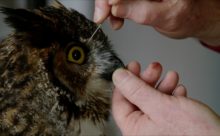Bird Taxidermy Apprenticeship Transcript
- When I started doing taxidermy, I had the opportunity to mount both mammals and birds. I just liked doing birds. I understood how the feathers all fell into place or needed to fall into place, so I just gravitated towards birds. One thing about bird taxidermy that I enjoy is the fact that you can position a bird in any particular pose you want, whether it's a landing pose, flying pose, a preening pose, fill in the blank pose. You have total creativity with the bird versus say, a mammal or or some other type of taxidermied animal. For the main reason, you can get a mannequin that is in the position that you already want to put the mammal, reptile, or fish in, whereas with birds, it's strictly the body. You have to then pose everything else with the bird, the head, the neck, the wings, the tail, the feet, the legs. One of the big aspects of bird taxidermy, I believe, is being able to understand how the bird looked when it was alive. A really good bird mount just captures the essence of the live bird. I'm very fortunate, I live on a marsh. I have a couple of cameras ready at hand. If I see birds flying, landing, or standing, and if I think it would be something to use as a reference, I take photos. Taxidermists are trying to recreate nature, and therefore we need to understand nature. We need to understand how the bird normally moves, how it flies, to how it interacts with the environment to be able to mount it properly.
I get the birds from hunters, nature centers, universities, the state of Massachusetts, Boston Park Police. It varies. Most birds are highly regulated. Either you have to have a hunting license or if a bird is found dead, you have to have a federal salvage permit as well as a state salvage permit to pick up the bird and have it mounted. I realized several years ago that I didn't wanna continue doing bird taxidermy into my seventies. Due to the number of clients I had already, I wanted to refer them to somebody that could do bird taxidermy very well. I offered to train several taxidermists near me, and Nikki took me up on that offer.
- I always loved anything taxidermy. I grew up going to Kennebunk, Maine every year and there was a taxidermist and we never went there, but I always would ask my parents what a taxidermist was and from there I kind of just always kept it in the back of my mind, and so it was just a weird obsession when I was a kid. I started taxidermy by finding a class out of the Harvard Natural History Museum, just for a small half-sized bunny, and it was just kind of the gateway into this world for me. I met Victor many years ago and I would sit with him while he did birds. I took a lot of notes, and once I started doing them more hands-on, I was able to retain a lot more information and then once we entered the apprenticeship together, it changed the whole world for me for birds.
- Nikki had experience with working with mammals. She had an understanding of skinning an animal, preparation and mounting. What it didn't prepare her for was how difficult birds are, because the skin is totally different from a mammal skin.
- Working with Victor has changed the way that I work with birds a lot, especially in an anatomical way, making sure that it looks as lifelike as possible. The bird that is sitting on the branch is one of my very first birds that I attempted without any real formal training at all. Its feet have not been painted and it has not been groomed properly, and I also struggled with placement of the wings and the head and the neck. The bird that is preening itself is the bird that I worked on with Victor. We used a lot of live reference photos of birds preening to get the exact look that we wanted with it, and we were able to make sure it was anatomically correct and that was one that won a few awards.
- I've been very pleased with Nikki's progress over the past year. Seeing where she is today is very gratifying. The apprenticeship program made that happen. Without the funding for her mileage, supplies, and my time for training her, and without a study plan that required us to get together on a fairly regular basis and think through the process of everything she would need to learn, she would not be where she is today. It really has made a big difference. So it is very nice that I can pass the torch to somebody so that people in Massachusetts can now have somebody else to take their birds to when I ultimately decide to retire.
